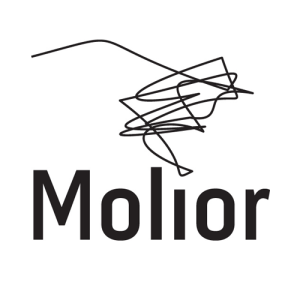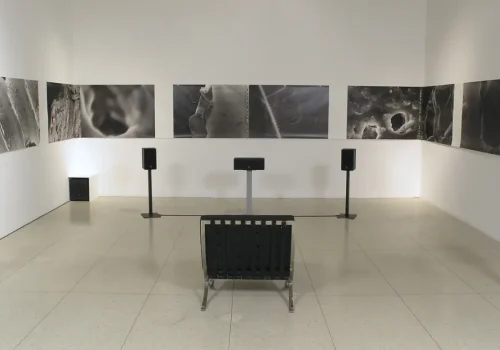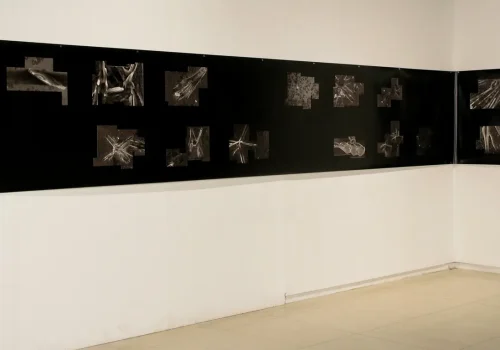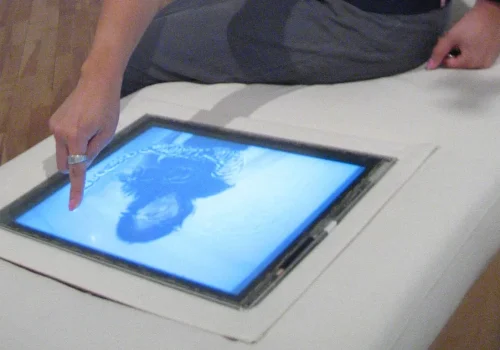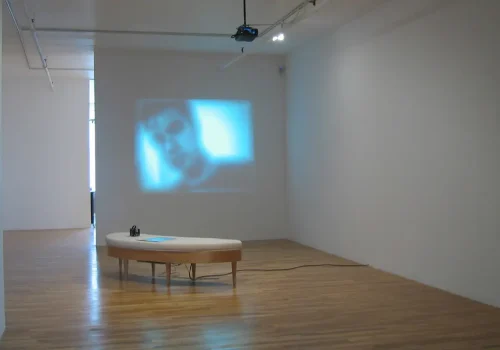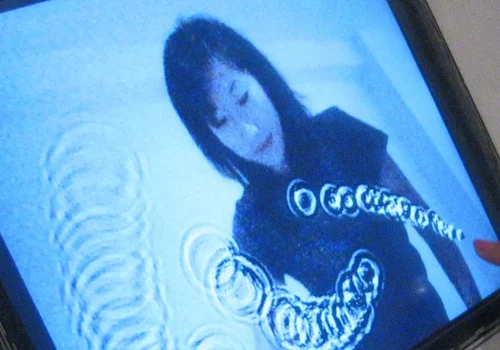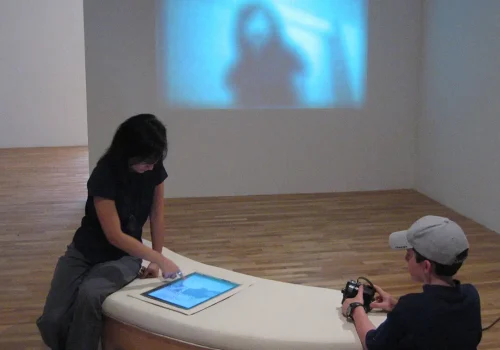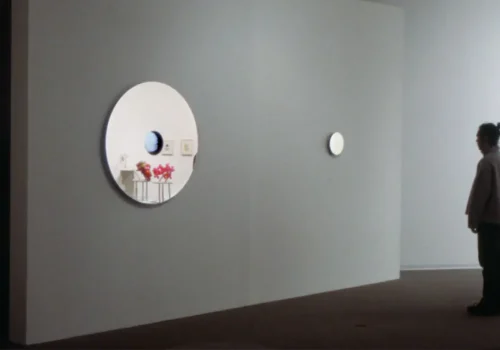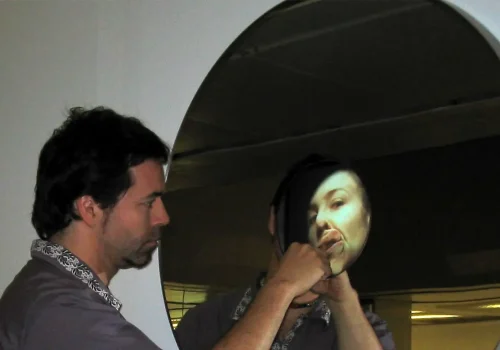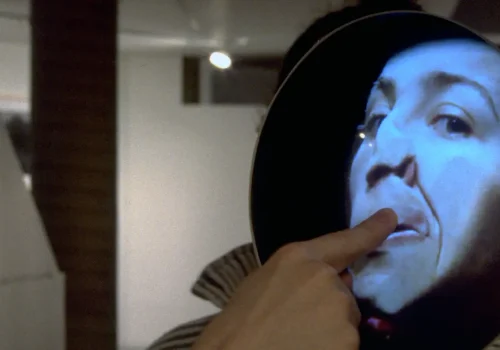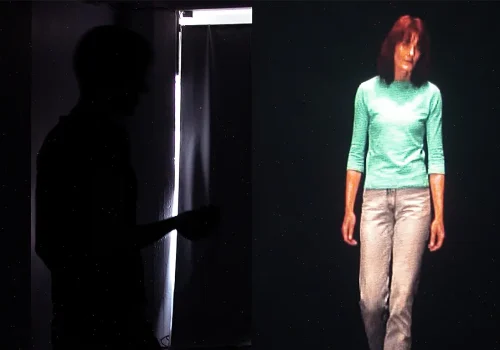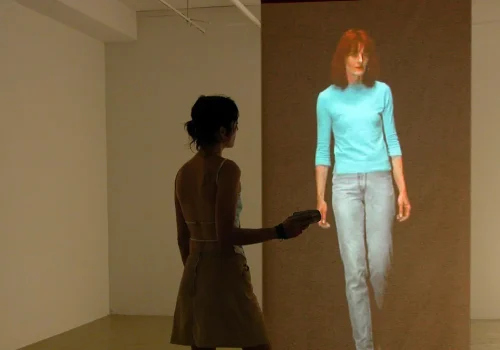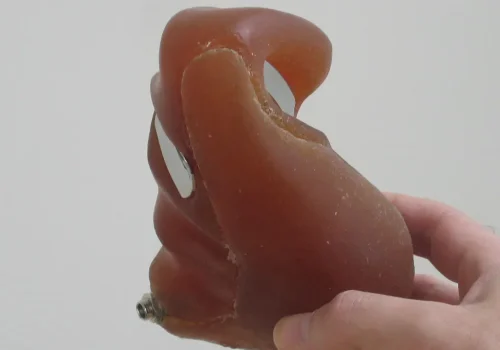À l’intérieur/Inside (São Paulo)
Paço das Artes, São Paulo
From May 5th to July 20th, 2008
Curator
Sylvie Parent
Artists
Following its very successful 2006 presentation in China as part of the Third Beijing International New Media Arts Exhibition and Symposium, the À l’intérieur/Inside exhibition, produced by the Groupe Molior, will be hosted by the Paço das Artes art centre in São Paulo, Brazil, from May 5 to July 20, 2008.
À l’intérieur/Inside / Sylvie Parent
We are, without a doubt, living in a world in which information and communication technologies have colonised all aspects of human activity, both public and private. This phenomenon is most apparent in urban areas. While this movement towards the computerisation of our environment and to remote access to information most affects large cities and their inhabitants, who are used to solicitations of all kinds and to the accelerated pace of social interactions, it can only become more prevalent and widespread.
The increasing presence of digital technologies and communication networks is profoundly altering our experience of the spaces in which we live and move about. This change is seen in the increasing number of screens displaying electronic content on walls, display units and materials of all sorts, both indoors and out. The tools of personal communication, for their part, are contributing to this same invasion of screens in individuals’ personal activities and spaces.
The omnipresence of screens large and small is having the effect of introducing sensorial experiences which compete with our experience of physical space. It is contributing to the mixing of multifarious perceptions and sensations and to the production of heterogeneous spatial conceptions which demand resolution. The screen, by taking its place in a space in which it superimposes itself on the space’s surfaces and the objects used by individuals, modifies the relationship we have established with the world, creating an “augmented” space. (1)
The instability of the content shown on these electronic surfaces gives rise to a superficiality and exteriority in a process of constant renewal. This is because the screen is not a surface which exists for itself. Its nature is to show something, always to show something else. By superimposing itself on another surface, which it replaces, it creates a break in the continuity of physical space, an empty zone which it constantly tries to fill, as if it were trying to hide this usurping, to fill the gap it creates in reality. (2) The screen takes charge of content, like a bottomless pit, in order to carry out its role as surface. It finds its worth in its ceaseless activity, in the replacement and renewal of its face. Occupied as it is to ensure its epidermal presence, by means of rapidly supplanted content, depth has little opportunity to take hold.
Under what conditions can the renewed “superficiality” of the screen lead to interiority? By what means can this ephemeral, discontinuous and variable digital information manage to create a path to the individual’s inner space, to the integration, understanding and experience of thought? Artists are often the first to be interested in the effects of the transformation of the social and cultural environment on human experience. The ubiquity of screens and the composite spatial experience they produce are at the heart of many artists’ work.
Some artists have opted for a more material presence of the screen in their work, engaging it in an unexpected dialogue with its environment or creating unusual tangible interfaces in order to create a more meaningful physical connection to the user. Tact by Jean Dubois and Perversely Interactive System by Lynn Hughes and Simon Laroche are works which employ such strategies as a way of contesting the familiarity we have acquired with digital displays, their uses and conventions.
Over the past few years, Jean Dubois has created a number of interactive projects with touch screens which establishes physical continuity between the participant and the digital content through touch. With Tact, the participant makes a face appear by pressing on an initially fuzzy screen which appears momentarily to grasp its fleeting image. Crushed against the screen, the face appears constrained not only to obey the movements of the participant’s finger, but also to remain within a very shallow space. Despite this presence, the participant never truly comes face to face with the image: the character returns to its indistinct space as soon as the participant stops touching the screen. The back and forth movement from one part of the screen to another that results from this interaction creates a supplementary space but does not manage to create a true sense of depth. A circular mirror around the screen, rather, offers the participant a paradoxical surface, both absorbent and reflective, in order to make of it an instrument which encourages engagement and a turning back to the self–a mediation system essential to the creation of interiority.
Lynn Hughes and Simon Laroche also propose an encounter with a virtual character in Perversely Interactive System. Accomplishing this face-to-face meeting relies entirely on the use of a tangible interface which measures the participant’s internal metabolism: the search for a relaxed state is a fundamental condition of the desired exchange. Perversely Interactive System thereby offers a completely out of the ordinary interactive situation, by addressing the world beneath the skin, the biological being. This inner consciousness, however, as corporeal as it may be, is not limited to a purely physiological experience. The character’s engaging presence and the gradual progression of the encounter keep the participant in a state of expectation. The relaxed state develops over time and is accompanied by a slowness favourable to a more widespread interiorisation, one which joins affect and intellect. The participant experiences a concomitant space, passing from his or her inner world to an objective manifestation supported by alterity.
Other artists pay special attention to the ubiquity of digital images. They examine what becomes of identity in situations in which the individual is solicited by multiple screens or when his or her presence itself is divided between different places through the use of networks. In these works, the question of the embodiment of the self and the image take centre stage. Alexandre Castonguay’s Digitale and beewoo’s habitgram, for example, lead the participant to reflect upon questions such as these.
Alexandre Castonguay’s interactive installation Digitale invites the visitor to be seated and to use an old camera to take both video images visible on a touch screen and still photographs projected onto the wall. These images, which are similar because they were taken with the same camera and in the same environment, nevertheless provide very different experiences. The image embedded in the bench asserts its desire for continuity and materiality while the projected still images reveal their fleeting nature, their degradation and immateriality. Digitale leads the participant to experience heterogeneous times and spaces by taking into account the impact of technology on the incarnation of the image. The recourse to tactility and the manipulation of the image involves participants physically and leads them to act as the creator of the image and/or an actor in the image. Participants can assume different roles in the installation, confirming their status as its author and/or subject, rendering them active or passive in this exercise of separating and distributing the image. They are thereby involved in a process which leads them to evaluate the impact of their subjectivity on the world of technology.
beewoo’s habitgram, for its part, puts to the test the spatial conception individuals have of their bodies and of the space they occupy by proposing that they don a coat equipped with cameras. What this piece of clothing sees with its multiple “eyes” is not the same as what the participant sees: the coat creates gaps and spaces whose effect is to destabilise perception. The projected images–oblique, unstable and variable–never completely conform to the orthogonal shape of the room nor even to the verticality of the body. By getting inside the coat, the participant is already extending his or her limits in space–by becoming “covered” in space. The walls on which the images produced by the coat are seen become in turn a larger piece of “clothing”. The experience of the habitgram invites the participant to assimilate and define space, no longer as something disconnected from oneself but rather as an extension of oneself. As an instrument for distributing the self, the work creates a loss of orientation, to a spatial confusion and to confusion around one’s identity which give rise to reflection. The spatialisation of the individual and his or her extension throughout the space lead to a critical evaluation of the ways in which images are created and individuals are disseminated. They also express the individual’s desire to establish an intimacy, a spatial continuity, with the world around them.
Other artistic projects using new media pay particular attention to the dimensions which evade our senses and convey the hidden depth of reality. They reveal the complexity of the world, its depth and plenitude, with the goal of countering the excess of superficiality brought on by the omnipresence of screens and solicitations which maintain the individual in a constant exteriority. This is the case, for example, with Brad Todd’s wave_scan and with the DATA project by Æ.
Brad Todd’s wave_scan project externalises in sounds and images phenomena that are invisible yet present, thereby causing to rise up out of the surrounding space an interiority which can’t be grasped by the senses or even the usual recording devices. The reading of very low frequency electromagnetic fluctuations is expressed by unusual sounds and images of water slowly filing by. The effect is to create an environment both poetic and enigmatic. The ambiguous nature of the sounds and images which convey this plenitude assert themselves in the space with the goal of soliciting subjective mental acts of creation. The images of water, taken in different settings, create a thematic continuity and refer to the universal presence of this element, as well as to its qualities of fluidity and adaptation. Water’s omnipresence and universality have the potential to produce a symbolic resonance for each individual, to call upon their personal memory and thus to enter their inner world.
Similarly, the project DATA, like many other works by Æ, is the result of a quest for the imperceptible, of a search among underground levels of reality beyond appearances. DATA’s digital images, created thanks to a residency in a scientific laboratory specialising in nanotechnology, engage our gaze in a depth of reality that is completely inaccessible to the senses. (3) The result of a complex instrumentation in the field of scientific analysis and imaging, they nevertheless remain mysterious and resist identification and didactic interpretation. Rather, their ambiguity creates curiosity about them and encourages observation. They are recreated in the space of the exhibit by adopting the configuration of the space and adhering to its structure and by re-affirming their bond with the world, for the reality they depict is well and truly founded upon the physical world. DATA proposes that we read these images, that we move about amongst them and plumb them as a way of viewing reality in all its complexity and depth.
Exteriority is inseparable from interiority and any external manifestation supposes a depth, an unfolding, a prolongation above the surface: “. . . when we see what is in front of us, why is something else still observing us, imposing an inside?”, Georges Didi-Huberman has written. (4) The superficiality of the screen thus demands to be overcome, made deeper, turned inside out, taken over. Against the trend towards exteriority, these artists propose, precisely, a physical, affective and intellectual engagement, an expressive spatialisation of the screen. They show the digital image in such a way as to create a creative tension between an inside and an outside of the surface of the screen. In doing so, they succeed in creating a space that provokes the realm of the imaginary.
Sylvie Parent
April 2006
- See Lev Manovich, The Poetics of Augmented Space, 2002-05 (www.manovich.net).
- On this topic, Olivier Asselin has written: “And our experience is essentially mixed and even heterogeneous: it is perforated by a multitude of screens and cameras which incessantly capture and transmit images, and export and import a variety of information. Our experience brings together different times and spaces–distant and nearby, private and public, past, present and future, factual and fictional–like a multi-dimensional strainer.” “Digital Screens”, Parachute 113 (2004):10.
- On the technology for visualising data in the field of nanotechnology, see Jim Gimzewski and Victoria Vesna, “The Nanome Syndrome”, HorizonZéro 14
- Georges Didi-Huberman, Ce que nous voyons, ce qui nous regarde (Paris: Minuit, 1992), 10.
Sylvie Parent
Sylvie Parent is an independent curator and art critic. She has been involved in the visual and digital arts scene for more than 30 years, both in Quebec and abroad. Her exhibitions have been shown in Canada, the United States, Italy, Brazil, China and Taiwan. From 2009 to 2014, she was artistic director of Molior, an organization specialized in the production of exhibitions on the international scene. In the field of publishing, Sylvie Parent acted as editor of magazines such as HorizonZero (2003-2005) and CIAC Electronic Magazine (1997-2000), and contributed to several specialized journals (Parachute, Ciel variable, Espace art actuel, etc.). She is also the author of numerous essays for exhibition catalogues. Sylvie Parent is a recipient of the Joan-Lowndes Award (2017) given by the Canada Council for the Arts to an independent art critic or curator in recognition of the outstanding quality of her work.
Artists & works
AE
Sweeping Spirals
DATA
2003-2006
Installation
Description of the work
DATA consists of a collection of multimedia works that incorporate images obtained using highly specialized scientific instruments, that is, scanning electron and atomic force microscopes. Such technology makes it possible to explore matter at its most fundamental level and observe molecular structure in terms of its chemical, magnetic and geometric components. At this scale, images can be obtained using viewing tools and by energy transfer, in addition to optical methods. The images that result from these processes engender curiosity and fascination, and give rise to questions about the power of representing what cannot be seen. The DATA project is adapted to each exhibition space in order to promote observation and elicit reflection about such images, the level of reality they present and the techniques which allow them to emerge. This project is part of broader research into the invisible and the inaudible, and levels of reality that are not immediately perceptible. Access to technology and acquisition of the documents were made possible by a residency at the Nanolab in McGill University’s Department of Chemistry, with the collaboration of Vicki Meli and Dr. Bruce Lennox. This project benefited from the support of the Daniel Langlois Foundation for Art, Science and Technology.
Biography
A research unit, Æ was founded in 1996 by artists Gisèle Trudel and Stéphane Claude. Their diverse creations showcase the duo’s interest in interdisciplinary collaboration between art and science, rooted in ecological and technological awareness. The work of Gisèle Trudel and Stéphane Claude has been shown extensively on the international art scene.
Alexandre Castonguay
Digitale
2003-2004
Interactive Installation
Description of the work
Digitale is an interactive installation comprising a wall projection and a bench on which an old still camera is placed. A touch-sensitive screen, incorporated into the bench, shows a video image picked up by this continuously operating camera. When a visitor touches this screen, concentric circles superimpose themselves on the image, making it shimmer as if it was reflected in the water, giving the image a new sense of materiality. The water’s fluidity suits the changing nature of the video image and highlights its mobility. Moreover, when participants press the camera’s shutter release, it produces a black and white still that is projected onto the wall. This photo gradually fades, giving way to an increasingly abstract representation. This fading process gives rise to reflection about the fragility of the memory evoked by the photographic image.
Participants can incorporate themselves into these images by turning the camera on themselves, then witness the transformation of their own image and connect with the effect of these devices on representation. Digitale thus invites an examination of the technologies used to capture and process the real (analog and digital photography and video) and a consideration of their ability to redefine the world.
Credits: The artist wishes to thank Mathieu Bouchard for his assistance.
Biography
The works of Alexandre Castonguay utilize open source technologies and software. His interactive installations and photographs have been featured in solo shows at the Musée d’art contemporain de Montréal and Mexico’s Centro de la Imagen. He has taken part in group shows at the Los Angeles County Museum of Art, the Canadian Museum of Contemporary Photography, as well in Beijing, Madrid, Berlin and Graz. He teaches at the University of Ottawa and is a founding member of Artengine.
beewoo
habitgram
2011
Interactive installation
Description of the work
Giving rise to an immersion environment and performances that vary with spectator involvement, habitgram presents a mise en abyme of the exhibition space. habitgram is a surveillance coat that all visitors are invited to wear in turn. The coat contains several camouflaged mini-cameras that pick up the immediate environment. The images captured by these cameras are multiplied on the gallery walls through real-time projections. The immediate area, thus multiplied, offers various perspectives of the site simultaneously; all perspectives change as the coat moves. Enshrouded by the moving, staggered images, participants can be disoriented and sometimes experience dizziness.
While the person wearing the habitgram becomes the performer and a producer of images, visitors in the same space are integrated into these images and participate in the installation as well. By donning the habitgram, participants are encouraged to “wear” the place in which they are standing, to become one with it and to redefine it while visitors who appear in these videos become actors, also appropriating the space. They actively become aware of their position in this space.
Biography
beewoo produces multimedia works both as a solo artist and as part of collectives such as KIT and Battery Operated. Her work has been presented at a number of festivals, including INVIDEO, Split, and FCMM, as well as in galleries like The Anchorage, New York; Stubnitz, Rostock; and China Millennium Art Museum, Beijing. beewoo is a founding member of the multimedia label C0C0S0L1DC1T1. As technical director at Studio XX, she is dedicated to open source technological arts and is pursuing her research into interactivity with the Interstices group. She also hosts the XX Files (women and technology) program on CKUT community radio.
Brad Todd
RedTV
2007-2008
Interactive installation
Description of the work
redTV, a Brad Todd installation, uses a computer application to capture a television signal in real time and present a garbled image next to a miniature TV that displays the source of the image. The moving red surfaces that emerge on the projected image result from changes wrought by the computer application. They leave traces, creating a history and map of their fluid appearance.
Biography
Brad Todd’s works span a variety of fields and include aspects of ubiquitous, tangible and responsive computing. In his past projects, he utilized telematics and reactive/augmented spaces to evoke memory, time, influence and hegemony of technology on the individual and social psyche. He is currently an instructor with Concordia University’s Computation Arts program.
Jean Dubois
Tact
2000-2001
Interactive video installation
Description of the work
Tact is an interactive video installation that can be controlled using a touch-sensitive screen. It sets up a meeting between the participant and an anonymous person located on the other side of the screen. The Tact program links video sequences in response to the participant’s various manipulations. Without using words, participants are invited to engage in gesticulative dialogue. By touching and rubbing, they eventually discover they are provoking unusual reactions from their virtual partner.
Literally, the word “tact” is synonymous with the sense of touch. Figuratively, however, it also means an intuitive, spontaneous and thoughtful appreciation of how it is appropriate to behave in a human relationship. The Tact project demonstrates the increasing presence of electronic mediation in interpersonal exchanges. The recent emergence of various network communication services (e-mail, forums, electronic chat) is giving rise to a particular type of public space where social relations are often filtered by anonymity or artificial identities. In many cases, these can be seen as an opportunity for openly expressing ourselves with others without actually exposing ourselves personally. Technology then plays a paradoxical role in that it provides direct access to others while maintaining a protective distance. In this kind of relationship, a strange mixture of inhibition and exhibition seems to appear.
Biography
From the start Jean Dubois has focused his research on the interactions of the body and technological devices, notably the touch screen and mobile telephony, as well as on the intersubjective relationships that underpin them.
His work also draws on a combinatory textuality structured around mots-valises, concrete poetry or polyphonic conversations.
His works have been shown in several art centres, museums, biennials and festival in Canada and abroad, notably at the Biennale internationale d’art numérique (Montreal), CyberFest at Hermitage Museum (Saint Petersburg), Biennale de Montréal, Incheon International Digital Art Festival (South Korea) and at the International Biennial of Media Art (Melbourne). Molior presented his interactive video panel Tact (2000-2001) in 2006 during the exhibition À l’intérieur/Inside put together by Sylvie Parent for the Third Beijing International New Media Arts Exhibition and Symposium at the Millennium Museum, and in 2009 as part of eARTS BEYOND: Shanghai International Gallery Exhibition of Media Art, under the artistic direction of Zhang Ga.
He teaches at École des arts visuels et médiatiques de l’Université du Québec à Montréal where, until just recently, he was the vice-dean of research and creation. He is also among the founding members of Hexagram, an interuniversity media arts research and creation centre and he was the chair of the board of directors of Vox, Centre de l’image contemporaine.
Lynn Hughes – Simon Laroche
Perversely Interactive System
2002
Interactive installation
Description of the work
Perversely Interactive System consists of a life size video projection that is controlled by a participant with a biofeedback handset. The handset measures galvanic skin resistance (variation in sweat gland activity). The participant can control the image (and associated sound) by lowering his/her internal stress level – for example by conscious muscle relaxation, breathing, meditation etc. The video projection begins with the image of a woman with her back turned. If the participant’s level of stress lowers, the (image of the) woman in the video will turn around and advance towards us. (If the participant then gets excited by this success however, the she pauses and waits).
This work plays on the symmetry, and the engagement, between the image of the person on the screen and the individual in front of the screen. The fact that the person on the screen is controlled by the body functions of the participant sets up a kind of empathy, an intimacy. At the same time the virtual other remains fugitive and difficult to control. The piece also focuses on the idea of appearance (or surface), in particular women’s appearance, as something that is both seductive and yet surprisingly opaque or resistant.
Biography
Lynn Hughes has a background in literature, art and history and the philosophy of science and technology. She holds a Research Chair at Montreal’s Concordia University, an institution at which she also teaches. She was instrumental in the design and structuring of Hexagram, the Montreal Institute for Research/Creation in Media Arts and Technologies. She is currently co-director of the Interstices Research Group, which develops media works.
Artist, teacher and interactive designer, Simon Laroche works in installation, audio and video performance, robotics and body art. With the EVA project collective, he develops a critical perspective on the hybridization and development of various biological, artificial and social systems. Simon Laroche teaches electronic arts at Concordia University and is also active in theatre, fashion design, dance and cinema.
